Blockchain
Blockchain (also called block chain) is a way of protecting digital content so that it becomes very difficult to copy. It relies on many other people having the exact same list of who owns a certain piece of digital content. If an unauthorized copy is made, other people will notice that their personal list is different to spot the counterfeit copy. Block chains keep the lists in the same order, so once an authorized item is given out, it cannot be changed. It can be viewed as having a list of paper where you write who owns each item in permanent ink that cannot be erased and then give the list to 1000's of people. Any change to the list will be spotted.
Blockchain can allow things to be traded without needing a middleman, such as a bank or company to make sure the trade is done securely. For example, you might want to sell a computer online. You would traditionally use a company, like ebay to help you with the sale and make sure the buyer gets what they ordered and that you get your money. With blockchain, we can use technology instead of a company to accomplish the same thing and do it much more securely and economically.
Bitcoin is one of the first widely adopted use of the blockchain. Block chain allows bitcoin, which is a form of digital currency, to be protected so that just like real money, a bit coin can only have one owner at a time.
A lot of computer science and advanced concepts in the field of cryptography go into securely implementing blockchain. A blockchain relies on thousands of computers all holding the same information. This makes things very robust and extremely difficult to take down the system.
An important concept in blockchain is that it is decentralized and can run without needing a single person or machine coordinating things. It also protects privacy, since there are no assigned people holding identifiable private information.
In order to understand blockchain better, we can look at an example. Suppose you have a group of people in a room that don't know each other. However, you want to be able to know the age of every person without any one person having access to every persons age. With blockchain, you would line up the people and tell them to tell their neighbor their age. The only thing the person would know is the age of the person next to them. If you later call all the people back and ask them for the age of the person they met, you would soon know the age of everyone, but nobody else in the room would have this information, keeping things private. If an extra unauthorized person was added to the room, nobody would know their age and the addition would be detected as fraud. If someone removes a person, you would find that you could not get the entire list of ages.
We can also use blockchain to detect if a person lied about the age of another person. Since there are many distributed copies of the original, we can privately compare the list of all ages in a group with other lists. If a person lied about another persons age, the list would not match and be flagged. Blockchain uses the concept of checksums as a compact way of verifying a list of data. Checksums produce a specific string of data or number to represent content. A small change in the content or order of the data results in large changes of the checksum. This allows one to quickly validate if a list is original and unaltered by using a short string of data as the output and comparing it with other checksums.

